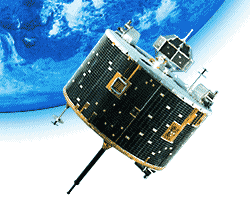COSPAR ID 1990-007A Website ISAS Hiten page Launch mass 197.4 kg Decay date 10 April 1993 | SATCAT no. 20448 Inclination 34.7° Launch site Uchinoura Space Center | |
 | ||
Names Muses-A (before launch) Mission duration 3 years, 2 months and 17 days Launch date 11:46:ss, January 24, 1990 (1990-01-24T11:46:ss)--> Operator Institute of Space and Astronautical Science Similar Nozomi, Lunar‑A, SELENE‑2, Explorer 35, Surveyor 6 | ||
Hiten s impact on the moon
The Hiten Spacecraft (ひてん, [hiteɴ]), given the English name Celestial Maiden and known before launch as MUSES-A (Mu Space Engineering Spacecraft A), part of the MUSES Program, was built by the Institute of Space and Astronautical Science of Japan and launched on January 24, 1990. It was Japan's first lunar probe, the first robotic lunar probe since the Soviet Union's Luna 24 in 1976, and the first lunar probe launched by a country other than the Soviet Union or the United States.
Contents
Hiten was to have been placed into a highly elliptical Earth orbit with an apogee of 476,000 km, which would swing past the Moon. However, the injection took place with a delta-v deficit of 50 m/s, resulting in an apogee of only 290,000 km. The deficiency was corrected and the probe continued on its mission.
On the first lunar swing-by, Hiten released a small orbiter, Hagoromo (はごろも, named after the feather mantle of Hiten), into lunar orbit. The transmitter on Hagoromo failed, but its orbit was visually confirmed from Earth. After the eighth swing-by, Hiten successfully demonstrated the aerobraking technique on March 19, 1991. This was the first aerobraking maneuver by a deep space probe. After the ninth lunar swing-by and second aero-braking maneuver on March 30, 1991, the primary mission of the probe was concluded.
First ballistic capture into lunar orbit
Edward Belbruno and James Miller of the Jet Propulsion Laboratory heard of the failure of the Hagoromo orbiter and helped to salvage the mission by developing a so-called ballistic capture trajectory that would enable the main Hiten probe to itself enter lunar orbit. Belbruno had been working on numerically modelling low-energy trajectories, and heard of the probe's problems. He developed a trajectory for the main probe to enter lunar orbit and on June 21, 1990, sent an unsolicited proposal to the Japanese space agency. They responded favorably, and later implemented a version of the proposal.
The trajectory Belbruno and Miller developed for Hiten used Weak Stability Boundary Theory and required only a small perturbation to the elliptical swing-by orbit, sufficiently small to be achievable by the spacecraft's thrusters. This course would result in the probe being captured into temporary lunar orbit using zero delta-v (called a ballistic transfer), but required five months instead of the usual three days for a Hohmann transfer. This was the first time a satellite had used low energy transfer to transfer to a moon orbit. On October 2, 1991, Hiten was captured temporarily into lunar orbit.
After that, Hiten was put into a looping orbit which passed through the L4 and L5 Lagrange points to look for trapped dust particles. The only scientific instrument on Hiten was the Munich Dust Counter (MDC), and no increase over background levels was found. On February 15, 1993, Hiten was placed into a permanent lunar orbit, where it remained until it was deliberately crashed into the lunar surface on April 10, 1993 at 34.3°S 55.6°E / -34.3; 55.6, between the craters Stevinus and Furnerius.
